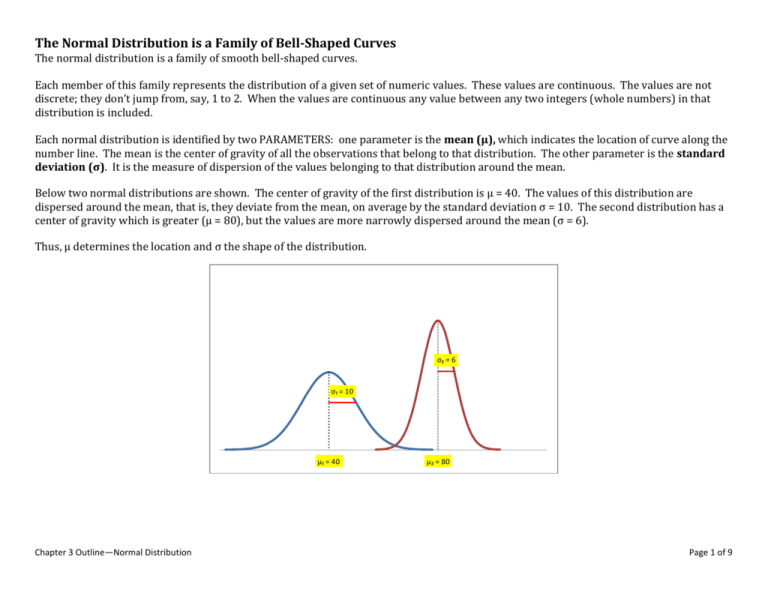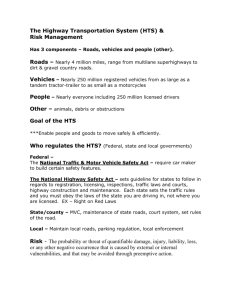3 Outline
advertisement

The Normal Distribution is a Family of Bell-Shaped Curves The normal distribution is a family of smooth bell-shaped curves. Each member of this family represents the distribution of a given set of numeric values. These values are continuous. The values are not discrete; they don’t jump from, say, 1 to 2. When the values are continuous any value between any two integers (whole numbers) in that distribution is included. Each normal distribution is identified by two PARAMETERS: one parameter is the mean (µ), which indicates the location of curve along the number line. The mean is the center of gravity of all the observations that belong to that distribution. The other parameter is the standard deviation (σ). It is the measure of dispersion of the values belonging to that distribution around the mean. Below two normal distributions are shown. The center of gravity of the first distribution is µ = 40. The values of this distribution are dispersed around the mean, that is, they deviate from the mean, on average by the standard deviation σ = 10. The second distribution has a center of gravity which is greater (µ = 80), but the values are more narrowly dispersed around the mean (σ = 6). Thus, µ determines the location and σ the shape of the distribution. σ₂ = 6 σ₁ = 10 μ₁ = 40 Chapter 3 Outline—Normal Distribution μ₂ = 80 Page 1 of 9 How to Determine Probability of 𝒙 Values in a Normal Distribution A continuous random variable can take on infinite number of values within an interval of numbers. Since the normal distribution is the distribution of a continuous random variable, the probability of any specific value is zero. Therefore, probability is defined only for an interval of values of a normal random variable, and is the area under the normal curve belonging to that interval. Example A normally distributed random variable X has a mean of μ = 60 and a standard deviation of σ = 8. What is the probability that 𝑥 is less than (less than or equal to) 52? What is the probability that x is less than (less than or equal to) 70? P(𝑥 < 52) = P(𝑥 ≤ 52) = ________ P(𝑥 < 70) = P(𝑥 ≤ 70) = ________ 52 60 x 60 Transform 𝑥 to 𝑧 (standard normal) 𝑥 − μ 52 − 60 𝑧= = = −1.00 σ 8 𝑧= 70 x 𝑥 − μ 70 − 60 = = 1.25 σ 8 P(𝑧 < 1.25) = 0.8944 P(𝑧 < −1.00) = 0.1587 0.8944 0.1587 -1.00 Chapter 3 Outline—Normal Distribution 0 z 0 1.25 z Page 2 of 9 μ = 60 σ=8 “Closed” intervals P(52 < 𝑥 < 68) = ______ 60 52 68 P(44 < 𝑥 < 76) = ______ x 𝑥 − μ 68 − 60 𝑧= = = 1.00 σ 8 𝑧= 52 − 60 = −1.00 8 0 76 x 76 − 60 = 2.00 8 𝑧= 84 − 60 = 3.00 8 𝑧= 44 − 60 = −2.00 8 𝑧= 36 − 60 = −3.00 8 0.6544 1.00 P(z < 1.00) = 0.8413 P(z < -1.00) = 0.1587 P(-1.00 < z < 1.00) = 0.6826 Chapter 3 Outline—Normal Distribution z 60 36 𝑧= 0.6826 -1.00 60 44 P(36 < 𝑥 < 84) = ______ -2.00 0 P(z < 2.00) = 0.9772 P(z < -2.00) = 0.0228 P(-2.00 < z < 2.00) = 0.9544 84 x 0.9974 2.00 z -3.00 0 3.00 z P(z < 3.00) = 0.9987 P(z < -3.00) = 0.0013 P(-3.00 < z < 3.00) = 0.9974 Page 3 of 9 Example Vehicle speed on a freeway is normally distributed with a mean of 77 mph (μ = 77) and standard deviation of 8 mph (σ = 8). What proportion of vehicles drive below 65 mph? P(x < 65) = ______ 65 𝑧= 77 What proportion of vehicles drive above 90 mph? P(x > 90) = _______ x 65 − 77 = −1.50 8 77 𝑧= 0 𝑃(𝑧 < −1.50) = 0.0668 Chapter 3 Outline—Normal Distribution z 90 What proportion of vehicles drive between 65 and 89 mph? P(65 < x < 89) = ______ x 90 − 77 = 1.63 8 65 𝑧= 0 P(z > 1.63) = 1 – P(z < 1.63) P(z > 1.63) = 1 – 0.9484 = 0.0516 z 77 65 − 77 = −1.50 8 89 𝑧= x 89 − 77 = 1.50 8 0 z P(z < 1.50) = 0.9332 P(z < −1.50) = 0.0668 P(-1.50 < z < 1.50) = 0.8664 Page 4 of 9 μ = 77 σ=8 What proportion of vehicles drive within ±10 mph from the mean. What proportion drive within ±1.8 standard deviations from the mean speed? NOTE: ±1.8 standard deviations from the mean simply represent the z-scores. The z-score, by definition, is the deviation from the mean expressed in units of σ. P(μ − 10 < 𝑥 < μ + 10) = P(67 < 𝑥 < 87) P(μ − 1.8σ < 𝑥 < μ + 1.8σ) = P(62.6 < 𝑥 < 91.4) 77 z = (67 – 77) ∕ 8 = -1.25 x 77 z = (87 – 77) ∕ 8 = 1.25 z = (62.6 – 77) ∕ 8 = -1.80 0 P(𝑧 < 1.25) = 0.8944 P(𝑧 < −1.25) = 0.1056 P(−1.25 < 𝑧 < 1.25) = 0.7888 Chapter 3 Outline—Normal Distribution x z = (91.4 – 77) ∕ 8 = 1.80 z 0 z P(z < 1.80) = 0.9641 P(z < -1.80) = 0.0359 P(-1.80 < z < 1.80) = 0.9282 Page 5 of 9 Changing Directions In the examples below, the probability is given and you are asked to find the interval of x values that is associated with that probability. Vehicle speed on a freeway is normally distributed with a mean of 77 mph (μ = 77) and standard deviation of 8 mph (σ = 8). Below what speed 30% (or 0.30 proportion) of vehicles drive? Above what speed 20% (or 0.20 proportion) of vehicles drive? x = ? 77 x Using the z-table, first find the z score that corresponds to an area (probability) that is closest to 0.30: z = -0.52 -0.52 0 𝑧= 𝑥−μ σ 𝒙 = μ + 𝒛𝛔 77 x = ? x Using the z-table, first find the z score that corresponds to an area (probability) that is closest to 0.80: z = 0.84 z 0 0.84 z 𝑥 = μ + 𝑧σ 𝑥 = 77 + 0.84(8) = 83.7 mph 𝑥 = 77 + (−0.52)(8) = 72.8 mph Chapter 3 Outline—Normal Distribution Page 6 of 9 Given, μ = 77 and σ = 8 The speed above which 10% (or 0.10 proportion) of vehicles drive is: P(x > ____) = 0.10 77 x The speed above which 5% (or 0.05 proportion) of vehicles drive is: P(x > ____) = 0.05 x The z-score that bounds a tail are of 0.10 is 𝒛𝟎.𝟏𝟎 = 𝟏. 𝟐𝟖 0 1.28 x 77 The speed above which 2.5% (or 0.025 proportion) of vehicles drive is: P(x > ____) = 0.025 x The z-score that bounds a tail are of 0.05 is 𝒛𝟎.𝟎𝟓 = 𝟏. 𝟔𝟒 z 0 1.65 77 x The z-score that bounds a tail are of 0.025 is 𝒛𝟎.𝟎𝟐𝟓 = 𝟏. 𝟗𝟔 z 0 𝑥 = μ + 𝑧σ 𝑥 = μ + 𝑧σ 𝑥 = μ + 𝑧σ 𝑥 = 77 + 1.28(8) = 87.2 mph 𝑥 = 77 + 1.64(8) = 90.1 mph 𝑥 = 77 + 1.96(8) = 92.7 mph P(𝑥 > 87.2) = 0.10 P(𝑥 > 90.1) = 0.05 P(𝑥 > 92.7) = 0.025 Chapter 3 Outline—Normal Distribution x 1.96 z Page 7 of 9 Given, μ = 77 and σ = 8 The middle speed interval which contains 80% (or 0.80) of all vehicles is: ____ to ____ P(____ < 𝑥 < ____) = 0.80 0 P(____ < 𝑥 < ____) = 0.90 x 77 -1.28 The speed interval which contains 90% (or 0.90) of all vehicles is: ____ to ____ 1.28 z 0 P(____ < 𝑥 < ____) = 0.95 x 77 -1.64 The speed interval which contains 95% (or 0.95) of all vehicles is: ____ to ____ 1.64 z -1.96 0 𝑥𝐿 = 77 + (−1.28)(8) = 66.8 𝑥𝐿 = 77 + (−1.64)(8) = 63.9 𝑥𝐿 = 77 + (−1.96)(8) = 61.3 𝑥𝑈 = 77 + (1.28)(8) = 87.2 𝑥𝑈 = 77 + (1.64)(8) = 90.1 𝑥𝑈 = 77 + (1.96)(8) = 92.7 𝑃(66.8 < 𝑥 < 87.2) = 0.80 𝑃(63.9 < 𝑥 < 90.1) = 0.90 𝑃(61.3 < 𝑥 < 92.7) = 0.95 Chapter 3 Outline—Normal Distribution x 77 1.96 z Page 8 of 9 On a different highway 5% of vehicles drive above 75 miles per hour. The standard deviation of vehicle speed is σ = 5. The mean vehicle speed is μ = _____. Yet, on another highway 2.5% of vehicle drive above 62 mph. The mean speed is 54 mph. The standard deviation of vehicle speed is σ = ____. 𝑥 = μ + 𝑧σ μ = 𝑥– 𝑧σ z0.05 = 1.64 σ=5 µ = 75 – 1.64(5) = 66.8 mph 𝑧= 𝑥−μ σ σ= 𝑥−μ 𝑧 z0.025 = 1.96 σ= Chapter 3 Outline—Normal Distribution 62 − 54 = 4.1 mph 1.96 Page 9 of 9









